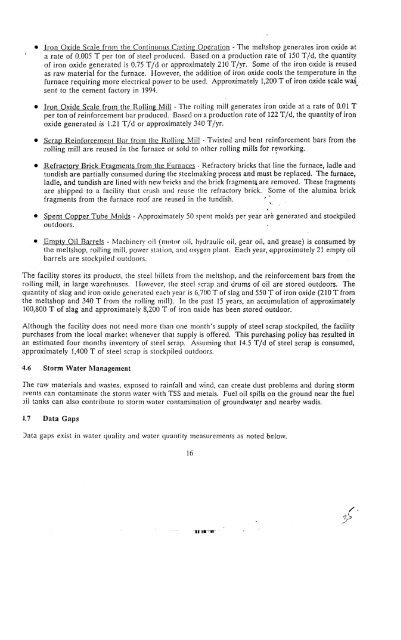Watcr Q!!alit\1 lmprovcmct1t at1() COf1scrvatiof1l'rojcct
Watcr Q!!alit\1 lmprovcmct1t at1() COf1scrvatiof1l'rojcct
Watcr Q!!alit\1 lmprovcmct1t at1() COf1scrvatiof1l'rojcct
You also want an ePaper? Increase the reach of your titles
YUMPU automatically turns print PDFs into web optimized ePapers that Google loves.
• Iron Oxide Scale from the Continuous CL~ting Operation - The meltshop generates iron oxide at<br />
a rate of 0.005 T per ton of steel produced. Based on a production rate of 150 Tid, the quantity<br />
of iron oxide generated is 0.75 Tid or approximately 210 T Iyr. Some of the iron oxide is reused<br />
as raw material for the furnace. However, the addition of iron oxide cools the temperature in the<br />
furnace requiring more electrical power to be used. Approximately 1,200 T of iron oxide scale w~.'<br />
sent to the cement factory in 1994.<br />
• Iron Oxide Scale from the Rolling Mill - The rolling mill generates iron oxide at a rate of 0.01 T<br />
per ton of reinforcement bar produced. Based on a production rate of 122 Tid, the quantity of iron<br />
oxide generated is 1.21 Tid or approximately 340 T jyr.<br />
• Scrap Reinforcement tiar from thc Rolling Mill - Twisted and hent reinforcement bars from the<br />
rolling mill are reused in the furnace or sold to other rolling mills fot r~working.<br />
• Refractory Brick Fragments from the Furnaces - Refractory bricks that line the furnace, ladle and<br />
tundish are partially consumed during the steelmaking process and must be replaced. The furnace,<br />
ladle, and tundish are lined with new hricks and the brick fragment& are removed. These fragments<br />
are shipped to a facility that crush and reuse the refractory briCk. Some of the alumina brick<br />
fragments from the furnace roof are reused in the tundish. "<br />
• Spent Copper Tuhe Molds - Approximately 50 spent molds per year are generated and stockpiled<br />
outdoors.<br />
• Empty Oil Barrels - Machinery oil (motor oil, hydraulic oil, gear oil, an(1 grease) is consumed by<br />
the meltshop, rolling mill, power station, amI oxygen plant. Each year, -approximately 21 empty oil<br />
barrels are stockpiled outdoors.<br />
The facility stores its products, the steel billets from the meltsbop, and the reinforcement bars from the<br />
rolling mill, in large warehouses. I {o\Vcver, the steel scrap and drums of oil are stored outdoors. The<br />
quantity of slag and iron oxide generated each year is 6,700 T of slag and 550 T of iron oxide (210 T from<br />
the meltshop and 340 T from the rolling mill). In the past 15 years, an accumulation of approximately<br />
100,800 T of slag and approximately 8,200 T of iron oxide has been stored outdoor.<br />
Although the facility does not need more than one month's supply of steel scrap stockpiled, the facility<br />
purchases from the local market whenever that supply is offered. This purchasing policy has resulted in<br />
an estimated four months inventory of steel scrap. Assuming that 14.5 Tid of steel scrap is consumed,<br />
approximately 1,400 T of steel scrap is stockpiled outdoors.<br />
4.6 Storm Water 1\1anagement<br />
The raw materials and wastes, exposed to rainfall and wind, can create dust problems and during storm<br />
~vents can contaminate the storm water with TSS and metals. Fuel oil spills on the ground near the fuel<br />
Jil tanks can also contribute to storm water contamination of groundwat~rand nearby wadis.<br />
t7<br />
Data Gaps<br />
Jata gaps exist in water quality and water quantity measurements as noted below.<br />
16<br />
/-<br />
9

















